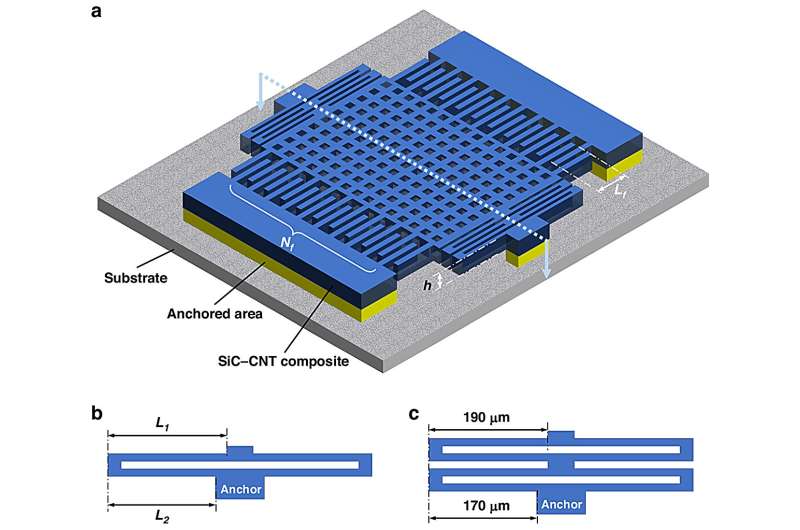This article has been reviewed according to Science X's editorial process and policies. Editors have highlighted the following attributes while ensuring the content's credibility:
fact-checked
peer-reviewed publication
proofread
Scientists develop composite accelerometer for extreme environments

The demand for microelectromechanical systems (MEMS) resilient to harsh environments is growing. Silicon-based MEMS struggle under extreme conditions, limited by their performance at elevated temperatures. Silicon carbide (SiC) stands out as a promising solution, offering unmatched thermal, electrical, and mechanical advantages for creating enduring MEMS.
Despite its potential, SiC MEMS development is challenged by the intricacies of bulk micromachining, calling for innovative strategies to harness SiC's strengths in crafting robust devices. In response, scientists have crafted an accelerometer using a novel silicon carbide-carbon nanotube (SiC-CNT) composite, capable of enduring severe environmental stress.
Published in Microsystems & Nanoengineering in April 2024, this research unveils a revolutionary material fusion, merging SiC's durability with the versatility and conductive qualities of CNTs.
This work merges the resilience of SiC with the versatility of CNTs. The team's approach involves growing a CNT array and densifying it with amorphous SiC via chemical vapor deposition, creating a material with outstanding mechanical strength, superior electrical conductivity, and high thermal stability.
This SiC-CNT composite enables the production of high aspect ratio structures, crucial for the sensitivity and efficiency of MEMS devices, while ensuring robust performance in extreme temperatures and corrosive environments.
Professor Sten Vollebregt, the lead researcher, stated, "This advancement not only overcomes longstanding fabrication challenges but also significantly enhances the mechanical and electrical properties of MEMS devices. Our SiC-CNT composite accelerometers are poised to revolutionize the deployment of MEMS in environments where conventional devices simply cannot survive."
The fabricated capacitive accelerometer showcased the composite's potential in MEMS applications, particularly for devices requiring operation in high-temperature, high-radiation, and corrosive environments. Such accelerometers are critical for aerospace, automotive, and industrial monitoring systems, where reliability under extreme conditions is paramount.
More information: Jiarui Mo et al, A high aspect ratio surface micromachined accelerometer based on a SiC-CNT composite material, Microsystems & Nanoengineering (2024). DOI: 10.1038/s41378-024-00672-x
Journal information: Microsystems and Nanoengineering
Provided by TranSpread




















